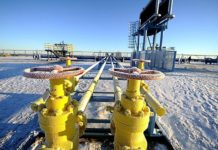As Russia’s state nuclear corporation Rosatom is preparing to launch the world’s first floating nuclear plant in the Arctic Ocean, activists warn that the project is risky and could turn to “Chernobyl on ice”, Euronews writes.
The ship, Akademik Lomonosov plant, is anchored in Murmansk, a Russian town only 200km from the Norwegian border. It is planned to sail off in a few weeks. The floating plant will then be towed 5000 kilometers through the Northern Sea Route to Pevek where it’s meant to provide heat and energy to local homes and help out with mining and drilling operations in Russia’s Chukotka region.
The 140-metre-long by 30-metre-wide ship that can transport 69 sailors at an average speed of four knots (7.5 km/h) in favourable conditions, is “designed for operation in the Far North and the Far East.”
Its main goal is to provide energy to remote industrial enterprises, port cities, as well as gas and oil platforms located in the sea,” Rosatom said in a statement. It also has a “large margin of safety, which exceeds all possible threats and makes nuclear reactors invulnerable to tsunamis and other natural disasters,” the company said. Rosatom also claimed the ship is “virtually unsinkable” and will not be affected by collisions with icebergs.
However, environmental NGOs have raised safety concerns concerning the project, with Greenpeace calling the nuclear plant a “Chernobyl on ice”.
“If a nuclear or radiation accident occurs in the Arctic, it will be much more difficult to eliminate its consequences than in Chernobyl. Liquidators will face harsh weather conditions, and hundreds or even thousands of kilometers can separate them from the necessary infrastructure. In such circumstances, no one has ever eliminated nuclear accidents, no one has such experience, and Rosatom is not ready for this,” said Konstantin Fomin, Greenpeace’s Arctic expert in a statement.












